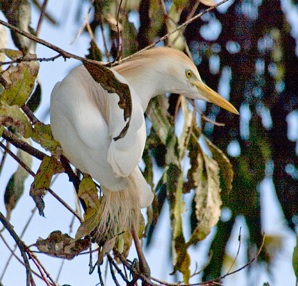A practical guide to bird watching in Sonoma County, California
(Unless otherwise indicated, all phone numbers are in the 707 area code)
A practical guide to bird watching in Sonoma County, California
(Unless otherwise indicated, all phone numbers are in the 707 area code)


Snowy Egret
Egretta thula
Usually seen standing in streams or ponds, or near lake edges or other shallow water looking for prey. Tends to shuffle around trying to see what it can scare up. Egrets, like herons, are communal roosters and nesters, however, and during nesting season (March to early June) they will be up in trees raising chicks along with other egrets and herons. Santa Rosa's Ninth St. Rookery is the site of dozens of nests each year--nests of this bird as well as Great Egret (Ardea alba), Cattle Egret (Bubulcus ibis), and Black-crowned Night Heron (Nycticorax nycticorax). May be seen foraging with other birds, including Great Egret. Besides the Ninth St. Rookery, nests in trees behind Spud Point Crab Company, Bodega Bay, and elsewhere in the county. In rookeries, Snowy Egret makes a very strange wubba-wubba-wubba sound. Otherwise, not a very vocal bird.

Further reading: National Geographic Field Guide to the Birds of North America, 5th ed., 2006, pg. 112; Peterson, Western Birds, 3rd ed., 1990, pg. 112; Peterson, Field Guide to Birds of Western North America, 4th ed., 2010, pg. 86; Sibley, Field Guide to Birds of Western North America,1st ed., 2003, pg. 57; Birds of Sonoma County California, rev. ed., 2000, pg. 24; The Birder's Handbook, paperback edition, 1988, pg. 40; Peterson, Birds of Eastern and Central North America, 5th ed., 2002, pg. 48; Burridge, ed., Sonoma County Breeding Bird Atlas, 1995, pg. 32.
Voice: Cornell Lab of Ornithology: All About Birds--Snowy Egret
© Colin Talcroft, 2009, 2010, 2011.
Unless noted, all photos by the author. If you would like to use one of my images, please ask for permission for non-commercial use with proper credit or commercial use with proper compensation.



Snowy Egrets in high breeding plumage, Ninth St. Rookery, Santa Rosa, April 16, 2011
Note the crest, the reddish skin around and in front of the eye (normally yellow), and the
long feathery plumes hanging from the bird's back and neck


Snowy Egret in flight, Bodega Bay.
Note the heavy neck, black bill, black legs, and yellow feet
An excellent view of the bright yellow feet,
often referred to as "golden slippers"
Snowy Egret in high breeding plumage showing: Full crest; long, up-curved breeding plumes on back; and breeding plumes at base of neck
For comparison: Cattle Egret in high breeding plumage. Note the heavy yellow bill and orange wash on head, back, and tail

For comparison: Great Egret. Note: Large size, lack of crest, very long neck, yellow bill, and black legs,